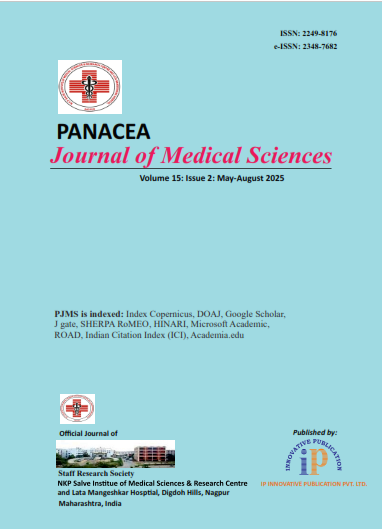Panacea Journal of Medical Sciences
Panacea Journal of Medical Sciences (PJMS) open access, peer-reviewed triannually journal publishing since 2011 and is published under auspices of the “NKP Salve Institute of Medical Sciences and Research Centre”. With the aim of faster and better dissemination of knowledge, we will be publishing the article ‘Ahead of Print’ immediately on acceptance. In addition, the journal would allow free access (Open Access) to its contents, which is likely to attract more readers and citations to articles published in PJMS.Manuscripts must be prepared in accordance with “Uniform requiremen...

Bolstering blood safety: Revealing six years of vigilance-NAT testing trends in infectious markers among tertiary care centre blood donors
Page: 341-345
Background: Transfusion transmitted disease was a major risk factor for Blood Transfusion. TTIs (HBV, HCV, HIV, Syphilis, Malaria) screening by ELISA was done mandatory for screening of Blood donors. In order to provide additional layer of safety IDNAT was implemented nowadays in few blood centres to increase the safety of blood transfusion. Recent studies shown that TTIs Risk was high in developing Countries.
Aim and Objective: This study was done to study the seroprevalence of TTI and estimate the benefits of implementing IDNAT in blood Donor Screening.
Materials and Methods: In this study data collection was done around 6 years. This study included 11,641 blood donors during study period. Among the donors, 9876 (84%) volunteered, while 1765 (15%) were replacement donors.
Result: The TTI seropositivity rate stood at 0.98% (n=114), with a prevalence of 0.67% for HBV, 0.21% for HCV, 0.06% for HIV, 0.04% for Syphilis, and 0% for Malaria. The NAT yield for HBV was determined to be one, while the yields for HCV, HIV, Syphilis, and Malaria were also calculated and found to be Zero. Decreasing Trend of TTI was seen from 2016-2022.
Conclusions: Our study documented low Prevalence of TTIs, low participation of female donors and decreasing trend of TTIs. The recommendations include the Promotion of enrolment of female donors and screening of donated blood through highly sensitive screening method (IDNAT).
Article Metrics
- Visibility 15 Views
- Downloads 5 Views
- DOI 10.18231/pjms.v.15.i.2.341-345
-
CrossMark
- Citation
- Received Date May 02, 2024
- Accepted Date March 08, 2025
- Publication Date August 19, 2025